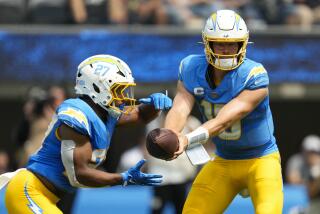No Stopping the Run-and-Shoot : Pro football: The Lions and Oilers lead their divisions with a combined 9-2 record--and are having fun doing it.
- Share via
Among high school coaches in the New Jersey area near Giants Stadium, there doesn’t seem to be a huge following for the NFL’s arch-conservative champions, the New York Giants.
Along with others in prep football, they show more interest in the stadium’s livelier spring tenant, the New York-New Jersey Knights of the World League of American Football.
That’s because an increasing number of young coaches favor run-and-shoot football, which was brought to the Knights by Mouse Davis, the man who created that offense.
And so at a Newark-area football clinic two months ago, the auditorium was packed when the principal speaker, Davis, arrived.
Walking briskly to the microphone, he looked the crowd over and asked: “Are any of you defensive coaches? Are you here to learn how to stop the run-and-shoot? If so, you might as well leave. There’s no way to stop it.”
Run-and-shoot partisans all believe that--literally or figuratively. So this year they are applauding an NFL development: The rise of the run-and-shoot in pro football.
The league’s two run-and-shoot teams are a combined 9-2 and leading their divisions.
The Detroit Lions, with Rodney Peete at quarterback and Barry Sanders running the ball, are 5-1 and first in the NFC Central, a game ahead of the Chicago Bears.
The Houston Oilers, with Warren Moon at quarterback, are 4-1 and first in the AFC Central.
“It doesn’t really surprise me,” Houston Coach Jack Pardee said the other day. “(The Lions and Oilers) are both doing the two things that count. First, we use a pass-first-and- then -run offense that’s hard to stop. Second, and just as important, we’re both playing very good defense.”
The key to the run-and-shoot, in Peete’s view, is that the players enjoy it.
“It’s fun to practice,” the USC-trained quarterback said.
Former Ram star Pardee said: “Instead of the usual practice drudgery, (the players) are absorbed by the nuances and details of the run-and-shoot.”
He listed some of the details:
--Four wide receivers are deployed on each play, on either goal line or anywhere in between, along with one running back.
--The quarterback starts under center on each play and retreats slightly right or left to throw the ball within two seconds. At times, he throws several passes consecutively. At times, depending on the defense he sees, he hands off to the single back for a fake-pass draw play--virtually the only run-and-shoot running play.
“Most spectators are surprised that the run-and-shoot doesn’t look much different from (conventional) football,” Pardee said. “Some media reports never mention it the next day. But it is very different. Ask the defensive linemen who have to stop it.”
At Detroit, Coach Wayne Fontes is in his third year in the run-and-shoot, which he combines with some of the Washington Redskins’ plays requiring two tight ends, two wide receivers and a single back.
Said Peete: “We’re in the run-and-shoot 75% of the time, and the (Redskin offense) the rest of the time.”
Former UCLA player Derek Tennell is one Detroit tight end, backup center Roman Fortin the other, and Fontes brings them in occasionally to beef up the blocking for Sanders.
Against good defensive teams, however, most of the Sanders yardage still comes on run-and-shoot draw plays.
When, for example, Detroit beat the Vikings in Minnesota on Sunday, Sanders got 46 of his 116 rushing yards on a variety of runs in the first 52 minutes. Then, in the last eight minutes, he added 70 yards on run-and-shoot draw plays.
The Vikings led, 21-3, with 6:50 to play, when Fontes abandoned Redskin football for the day. Instantly, Peete threw two quick run-and-shoot touchdown passes. Next, with the Vikings closely watching Peete once more, Sanders escaped on a 15-yard run-and-shoot draw play on third and six to score the winning touchdown, 24-21.
The Oilers, by comparison, don’t run that well in the run-and-shoot--in part because, relying on Moon’s artistry, they overuse passes.
Said Davis: “You’ve got to run as well as shoot. When the day is over and you look back, you probably won if you averaged one run in every three plays.”
More to Read
Go beyond the scoreboard
Get the latest on L.A.'s teams in the daily Sports Report newsletter.
You may occasionally receive promotional content from the Los Angeles Times.










